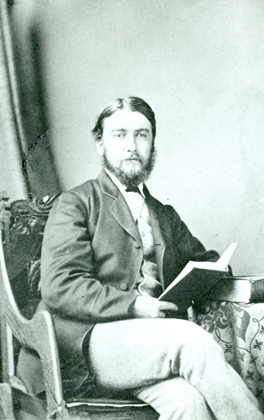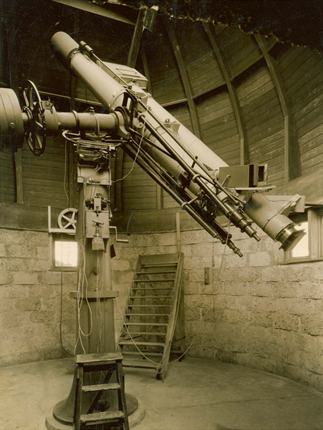University of Exeter Special Collections are pleased to announce that the papers of Astronomer, Sir Joseph Norman Lockyer are now available to consult online as part of Wiley Digital Archive’s British Association for the Advancement of Science Database (Collections on the History of Science: 1830-1970). Students at University of Exeter (and other institutions with the relevant subscription) can access the digitised material through their institutional login. A free trial subscription is also available at https://www.wileydigitalarchives.com/british-association-for-the-advancement-of-science/
Sir Joseph Norman Lockyer (1836-1920), astronomer, was one of the pioneers of astronomical spectroscopy and became one of the most influential astronomers of his time. His main interest was sun spectroscopy, which led him to discover helium independently of Pierre Janssen, a scientist who posited its existence in the same year. He was born in Rugby in 1836, the only son of a surgeon-apothecary, Joseph Hooley Lockyer and was educated privately in England and he also studied languages on the Continent. At the age of twenty-one became a clerk in the War Office, and married Winifred James in the following year. He developed interests in astronomy and journalism, and in 1863 began to give scientific papers to the Royal Astronomical Society. He proceeded to push back the frontiers of spectroscopy and science, discovering the theoretical existence of helium (a chemical not then known on Earth), and was awarded a medal by the French Academy of Sciences in the same year for developing a new technique to observe solar prominences at times other than eclipses.

Sir Norman Lockyer as Science Editor of The Reader
In 1869 Lockyer founded the journal ‘Nature’, which he edited until a few months before his death, and which remains to this day a major resource for international scientific knowledge. In 1870 he was appointed secretary to the Royal Commission on Scientific Instruction, which over the next five years reported on scientific education and resulted in the government setting up a laboratory of solar physics at South Kensington. To further this work, Lockyer was transferred from the War Office to the Science and Art Department at South Kensington in 1875. Here he organised an international exhibition of scientific apparatus, as well as establishing the loan collection which eventually formed the nucleus of the collections of the Science Museum.
Throughout this period, Lockyer continued to be active in astronomical observations and in spectroscopic studies in the laboratory of the College of Chemistry; he also wrote several books on astronomy and spectral analysis. Lockyer also studied the correlations between solar activity and weather, and developed interests in meteorology. In 1878 he was given charge of the solar-physics work then being carried out at South Kensington, being made Director of the Solar Physics Laboratory. Lockyer also became a lecturer in the Normal School Science in 1881, and became the first professor of astronomical physics in 1887, a post which he held until 1901. (In 1890 the School was renamed the Royal College of Science, which later became part of the Imperial College of Science and Technology). Lockyer continued his work as Director of the Solar Physics Laboratory until the laboratory moved to Cambridge, with the original laboratory site being used in part in the building of the Science Museum.

Kensington Telescope at Hill Observatory
After retiring to Devon with his wife, Lockyer established a solar observatory at Sidmouth on the suggestion of Francis McLean, the son of the astronomer and philanthropist Frank McLean. This observatory, begun in 1912, was set up for astrophysical observations, and was originally called the Hill Observatory. Following the completion of building work at the site at Salcombe Regis, near Sidmouth, Devon, solar work commenced in 1913 using the Kensington telescope which had been brought from the observatory in South Kensington, London. The Observatory was officially established as a charitable trust in 1916, and was renamed in Lockyer’s honour by his family after he died in Salcombe Regis, Devon, in August 1920. The Lockyer family continued to play an important role in the running of the observatory. Following a generous endowment from Robert Mond, the Observatory was established as a centre of astronomical excellence, and later became The Norman Lockyer Observatory Corporation of the University of Exeter (University College of the South West of England until 1955). The principal telescopes were donated by Lockyer and by Francis McLean, who had originally suggested the building of the observatory. A further telescope was donated by Robert Mond in 1932. The observatory is still running today.
The collection that has been digitised includes the personal correspondence and some of the research papers of Sir Norman Lockyer. The ‘Marconi telegram’ is also included, notifying Sir Norman Lockyer of the first Atlantic transmission using Ether waves, sent from Marconi at Mullion, Cornwall, to Sir Norman Lockyer of the Solar Physics Observatory, South Kensington, London, 12 January 1903, with copy telegram on reverse to Marconi from Norman Lockyer confirming receipt. Amongst the research papers are two boxes of eclipse notebooks 1870-1911, lecture notes 1870-1898, notes about articles, papers relating to the Royal Commission on Scientific Instruction 1871-1877, papers relating to the transfer of the Solar Physics Laboratory to Cambridge 1911-1912, and other papers relating to education, lectures and addresses. Other personal papers include those arising from his being awarded honorary degrees and his attendance at public functions.
I am researching the two Newall’s, Robert Stirling and son Hugh Frank. I would be interested in knowing if you have any correspondence in your archive regarding them. I know Lockyer had some involvement with the construction of the Newall Telescope and visited Ferndene – Newall’s residence – on a few occasions. Also, the son H F Newall was involved with the SPO when it was moved to Cambridge.
Dear Stewart,
The archive does indeed hold correspondence from the Newall’s. I’ve detailed a few below, but there may be more in the archive. You can find out more about visiting us, and book a Reading Room appointment at https://libguides.exeter.ac.uk/archives/visiting.
Hugh Frank
EUL MS 110/609 – 8 x letters 1892-1912
EUL MS 110/610 – 5 x letters 1912-1914
Robert Stirling:
EUL MS 110/610 – 5 x letters 1871-73
EUL MS 110/611 – 5 x letters – 1873-1877
EUL MS 110/add/1/5 – Correspondence relating to Meadows biography of Lockyer – 2 x letters 1875 &1877
I am so excited to be researching Sir Norman and am grateful for all the hard work that has been involved in the digitisation process. It is amazing that this wealth of archive material exists. A member of the Observatory, my aim is to gain an understanding of the type of person Sir Norman was and place his astronomical achievements in the context of his other work.